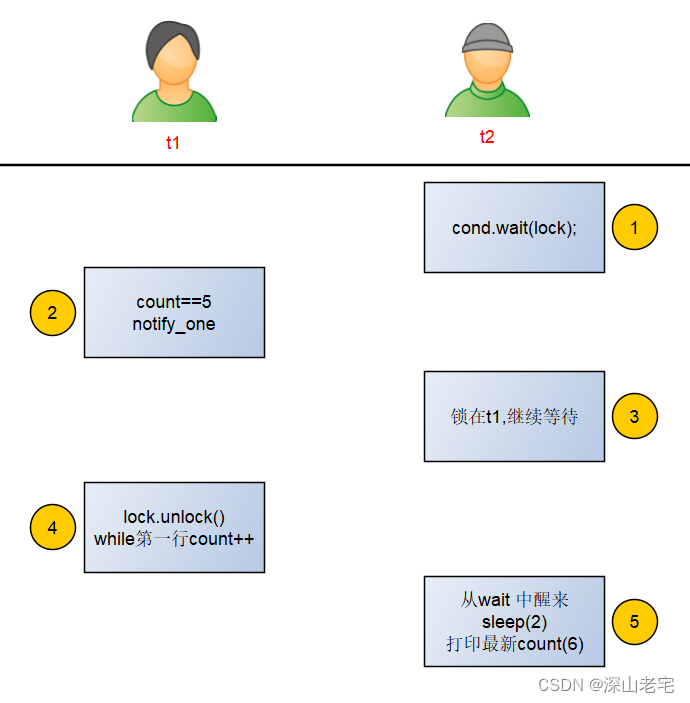互斥量是一种同步原语,是一种线程同步的手段,用来保护多线程同时访问的共享数据。
2、std::mutex_mutex:带超时的独占互斥量,不能递归使用。
3、std::recursive_mutex:递归互斥量,不带超时功能。
4、std::recursive_timed_mutex:带超时的递归互斥量
独占互斥量std::mutex
这些互斥量的基本接口很相似,一般用法是通过lock()方法来阻塞线程,直到获得互斥量的所有权为止。在线程获得互斥量并完成任务之后,就必须使用unlock()来解除对互斥量的占用,lock()和unlock()必须成对出现。try_lock()尝试锁定互斥量,如果成功则返回true,如果失败则返回false,它是阻塞的。std::mutex的基本用法如下代码。
#include <iostream>
#include <thread>
#include <mutex>
#include <chrono>
using namespace std;
std::mutex g_lock;
void func()
{
g_lock.lock();
cout << "enter thread: " << std::this_thread::get_id() << endl;
std::this_thread::sleep_for(std::chrono::seconds(1));
cout << "leaving thread: " << std::this_thread::get_id() << endl;
g_lock.unlock();
}
///g++ mutex.cpp -lpthread
int main()
{
std::thread t1(func);
std::thread t2(func);
std::thread t3(func);
t1.join();
t2.join();
t3.join();
return 0;
}enter thread: 140569127851776
leaving thread: 140569127851776
enter thread: 140568859412224
leaving thread: 140568859412224
enter thread: 140568590972672
leaving thread: 140568590972672使用lock_guard可以简化lock/unlock的写法,同时也更安全,因为lock_guard在构造函数时会自动锁定互斥量,而在退出作用域后进行析构时就会自动解锁,从而保证了互斥量的正确操作,避免忘记unlock操作,因此,应尽量用lock_guard。lock_guard用到了RAII技术,这种技术在类的构造函数中分配资源,在析构函数中释放资源,保证资源在出了作用域之后就释放,上面的例子使用lock_guard后更简洁,代码如下:
#include <iostream>
#include <thread>
#include <mutex>
#include <chrono>
using namespace std;
std::mutex g_lock;
void func()
{
std::lock_guard<std::mutex> locker(g_lock);///出了作用域之后自动解锁
cout << "enter thread: " << std::this_thread::get_id() << endl;
std::this_thread::sleep_for(std::chrono::seconds(1));
cout << "leaving thread: " << std::this_thread::get_id() << endl;
}
///g++ mutex.cpp -lpthread
int main()
{
std::thread t1(func);
std::thread t2(func);
std::thread t3(func);
t1.join();
t2.join();
t3.join();
return 0;
}递归的独占互斥量std::recursive_mutex
递归锁允许同一个线程多次获得该互斥锁,可以用来解决同一个线程需要多次获取互斥量死锁的问题。在下面的代码中,一个线程多次获取同一个互斥量时会发生死锁。
#include <iostream>
#include <thread>
#include <mutex>
#include <chrono>
using namespace std;
struct Complex
{
public:
Complex(){i = 20;}
void mul(int x)
{
printf("%s %s %dn", __FILE__, __func__, __LINE__);
g_mutex.lock();
///std::lock_guard<std::mutex> locker(g_mutex);
i *= x;
printf("%s %s %dn", __FILE__, __func__, __LINE__);
g_mutex.unlock();
}
void div(int x)
{
printf("%s %s %dn", __FILE__, __func__, __LINE__);
g_mutex.lock();
///std::lock_guard<std::mutex> locker(g_mutex);
i /= x;
printf("%s %s %dn", __FILE__, __func__, __LINE__);
g_mutex.unlock();
}
void both(int x, int y)
{
///std::lock_guard<std::mutex> locker(g_mutex);
g_mutex.lock();
printf("%s %s %dn", __FILE__, __func__, __LINE__);
mul(x);
div(y);
g_mutex.unlock();
printf("%s %s %dn", __FILE__, __func__, __LINE__);
}
private:
int i;
std::mutex g_mutex;
};
///g++ mutex.cpp -lpthread
int main()
{
Complex complex;
complex.both(2, 4);
return 0;
}
这个例子运行起来就会发生死锁,因为在调用both时获取了互斥量,之后再调用mul又要获取相同的互斥量,但是这个互斥量已经被当前线程获取了,无法释放,这时就会发生死锁。要解决这个死锁的问题,一个简单的办法就是用递归锁:std::recursive_mutex,它允许同一个线程多次获得互斥量。
#include <iostream>
#include <thread>
#include <mutex>
#include <chrono>
using namespace std;
struct Complex
{
public:
Complex(){i = 20;}
void mul(int x)
{
printf("%s %s %dn", __FILE__, __func__, __LINE__);
g_mutex.lock();
///std::lock_guard<std::recursive_mutex> locker(g_mutex);
i *= x;
printf("%s %s %dn", __FILE__, __func__, __LINE__);
g_mutex.unlock();
}
void div(int x)
{
printf("%s %s %dn", __FILE__, __func__, __LINE__);
g_mutex.lock();
///std::lock_guard<std::recursive_mutex> locker(g_mutex);
i /= x;
printf("%s %s %dn", __FILE__, __func__, __LINE__);
g_mutex.unlock();
}
void both(int x, int y)
{
///std::lock_guard<std::recursive_mutex> locker(g_mutex);
g_mutex.lock();
printf("%s %s %dn", __FILE__, __func__, __LINE__);
mul(x);
div(y);
g_mutex.unlock();
printf("%s %s %dn", __FILE__, __func__, __LINE__);
}
private:
int i;
std::recursive_mutex g_mutex;
};
void func()
{
Complex complex;
complex.both(2, 4);
}
///g++ mutex.cpp -lpthread
int main()
{
thread t1(func);
t1.join();
return 0;
}需要注意的是尽量不要使用递归锁,主要原因如下:
1、需要用到递归锁定的多线程互斥处理往往本身就是可以简化的,允许递归互斥很容易放纵复杂逻辑的产生,从而导致一些多线程同步引起的问题。
2、递归锁比起非递归锁,效率会低一些。
带超时的互斥量std::timed_mutex
std::timed_mutex是超时的独占锁,主要用在获取锁时增加超时等待功能,因为有时不知道获取锁需要多久,为了不至于一直在等待获取互斥量,就设置一个等待超时时间,在超时后还可以做其他事情。
std::timed_mutex比std::mutex多了两个超时获取锁的接口:try_lock_for和try_lock_until,这两个接口是用来设置获取互斥量的超时时间,使用时可以用while循环取不断地获取互斥量。std::timed_mutex的基本用法如下所示。
#include <iostream>
#include <thread>
#include <mutex>
#include <chrono>
using namespace std;
std::timed_mutex g_mutex;
void work()
{
std::chrono::milliseconds timeout(1000);
while(true)
{
if (g_mutex.try_lock_for(timeout))
{
cout << std::this_thread::get_id() << ": do work with the mutex" << endl;
std::chrono::milliseconds sleepDuration(5000);
std::this_thread::sleep_for(sleepDuration);
g_mutex.unlock();
std::this_thread::sleep_for(sleepDuration);
}
else
{
cout << std::this_thread::get_id() << ": do work without the mutex" << endl;
std::chrono::milliseconds sleepDuration(2000);
std::this_thread::sleep_for(sleepDuration);
}
}
}
///g++ mutex.cpp -lpthread
int main()
{
std::thread t1(work);
std::thread t2(work);
t1.join();
t2.join();
return 0;
}在上面的例子中,通过一个while循环不断地去获取超时锁,如果超时还没有获取到锁就会休眠,再继续获取超时锁。
原文地址:https://blog.csdn.net/qq_25048473/article/details/134611237
本文来自互联网用户投稿,该文观点仅代表作者本人,不代表本站立场。本站仅提供信息存储空间服务,不拥有所有权,不承担相关法律责任。
如若转载,请注明出处:http://www.7code.cn/show_12765.html
如若内容造成侵权/违法违规/事实不符,请联系代码007邮箱:suwngjj01@126.com进行投诉反馈,一经查实,立即删除!






